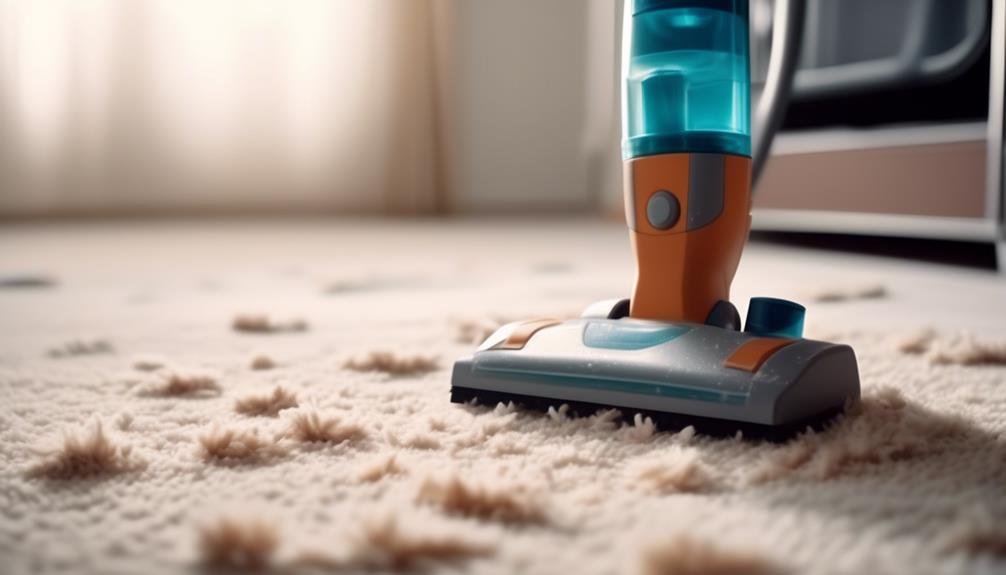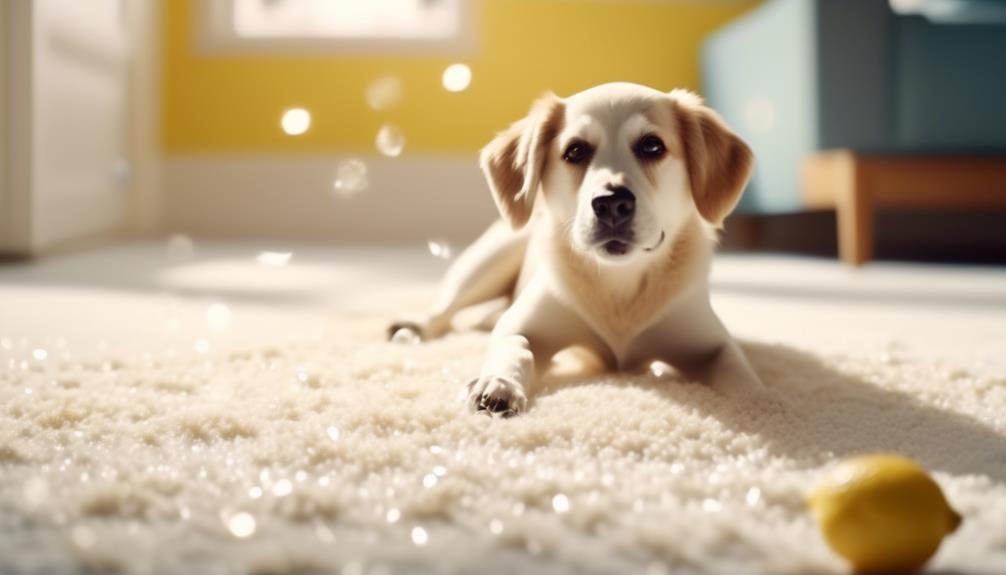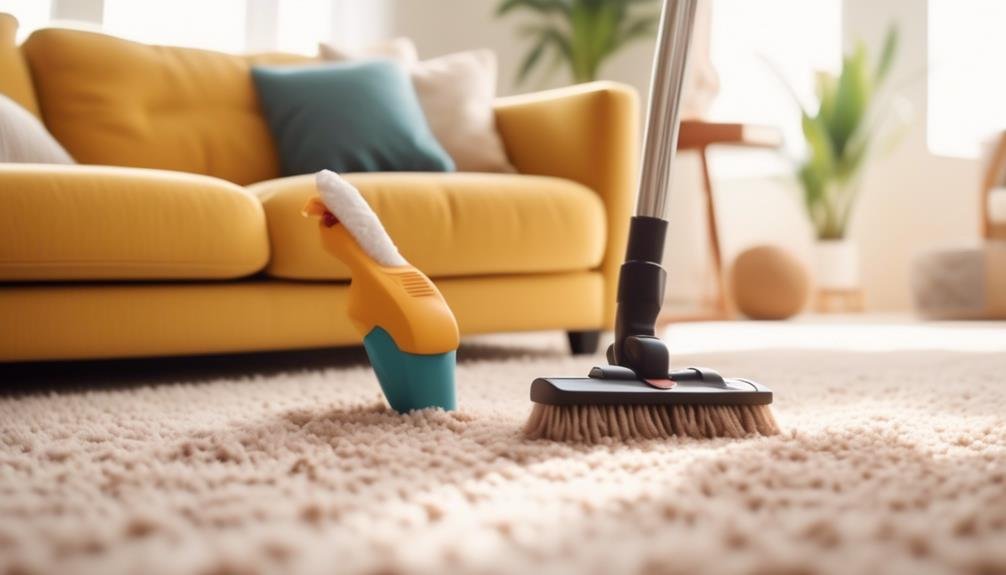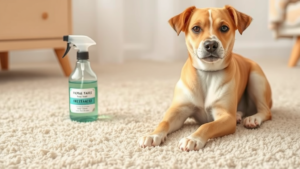It's frustrating when your beloved pet decides to make a mess on the carpet right after you've cleaned it. But you're not alone in this battle against stubborn pet stains. With my years of experience, I've learned that successfully cleaning these stains requires mastering the art of DIY carpet cleaning. So, let me guide you through the process of creating an effective homemade stain remover, step by step.
Understanding the nature of pet stains is crucial. These stains often contain proteins that can leave behind a strong odor and discoloration if not treated properly. That's why it's important to act quickly and tackle the stain as soon as it happens.
Now, let's dive into making your own homemade stain remover. Start by combining one tablespoon of dish soap with two cups of warm water. Mix it well until it forms a soapy solution. Then, gently blot the stained area with a clean cloth soaked in the solution. Avoid rubbing, as it may spread the stain further.
If the stain persists, you can try using a vinegar solution. Mix equal parts of white vinegar and water, and apply it to the stain. Let it sit for a few minutes, then blot it with a clean cloth. Vinegar is known for its ability to break down pet stains and eliminate odors.
For particularly stubborn stains, you may need to use a specialized pet stain remover. Look for products that are specifically designed to tackle pet stains and odors. These cleaners usually contain enzymes that break down the proteins in the stains, effectively removing them.
Remember to always test any cleaning solution on a small, inconspicuous area of your carpet before applying it to the entire stain. This will help you ensure that the solution doesn't cause any discoloration or damage.
In addition to using the right cleaning solutions, there are a few tips that can help you achieve better results. Firstly, always blot the stain instead of rubbing it, as rubbing can push the stain deeper into the carpet fibers. Secondly, work from the outside of the stain towards the center to prevent spreading. Lastly, make sure to thoroughly rinse the area with water and blot it dry to remove any residue.
By mastering the art of DIY carpet cleaning, you can effectively conquer those stubborn pet stains and keep your carpets looking vibrant and clean. Remember to act quickly, use the right cleaning solutions, and follow the proper techniques. With a little patience and the right tools, you'll be able to turn those dreaded moments into opportunities for triumph. So, don't let pet stains get you down – you've got this!
Understanding Pet Stains

Understanding Pet Stains
Before you start cleaning up a pet stain, it's important to know that not all pet stains are the same. Knowing the difference can make your cleaning efforts much more effective. You've probably faced the challenge of dealing with a fresh accident versus an old, set-in stain. Fresh stains are generally easier to handle, but don't worry, there's still hope for the older ones. It's all about using the right approach.
Accidents happen, and when they do, how quickly you react can make a big difference. Acting fast prevents the stain from seeping deep into the carpet fibers, making it easier to remove. But let's be realistic, sometimes you don't notice these accidents right away. That's when knowledge becomes your best friend. Different types of stains, like urine, feces, and vomit, require different cleaning solutions. Understanding what these stains are made of helps you choose the right cleaner. You want one that can effectively break down the stain without causing damage to your carpet.
To simplify things, let's break it down step by step. First, determine the type of stain you're dealing with. Is it urine, feces, or vomit? Each requires a specific cleaning approach. Once you've identified the stain, choose a cleaner that's designed to tackle that particular type of stain. For example, there are enzymatic cleaners that are specifically formulated to break down pet urine stains. These cleaners contain enzymes that target the organic material in the urine, effectively eliminating the stain and odor.
When using a cleaner, it's important to follow the instructions on the label. Some cleaners need to be diluted with water, while others can be used directly. Apply the cleaner to the stain and let it sit for the recommended amount of time. This allows the cleaner to penetrate the stain and break it down. After the designated time, blot the stain with a clean cloth or paper towel. Avoid rubbing the stain, as this can spread it further into the carpet fibers.
If the stain is old and set-in, you may need to repeat the cleaning process multiple times. Old stains can be stubborn, but with persistence, you can often make them less noticeable or even remove them completely. It's also a good idea to consider professional carpet cleaning for particularly stubborn stains or if you're unable to remove the stain on your own.
In addition to cleaning the stain, it's important to address any lingering odor. Even if the stain is gone, the smell can linger if not properly treated. There are odor-neutralizing sprays and powders available that can help eliminate pet odors. Look for products that specifically target pet odors and follow the instructions for best results.
Remember, prevention is key when it comes to pet stains. Regularly clean and maintain your carpets to minimize the risk of stains and odors. Vacuuming regularly and promptly cleaning up any accidents can go a long way in keeping your carpets clean and fresh.
Immediate Cleaning Importance
When your pet has an accident on your carpet, it's crucial to take immediate action. Acting quickly can make a significant difference in preserving the look and feel of your carpet. The longer pet stains sit, the deeper they seep into the fibers, making them more difficult to remove and increasing the risk of permanent damage. It's not just about how your carpet looks; it's also about maintaining a clean and healthy environment for you and your family.
Time is of the essence when it comes to pet accidents. The sooner you address them, the better your chances are of avoiding stubborn stains that linger and unpleasant odors. While it's important not to panic, it's essential to act purposefully. Start by blotting up as much of the accident as you can with paper towels or a clean, dry cloth. Remember, the key is to blot, not rub, to prevent pushing the stain deeper into the carpet.
By acting quickly and following these steps, you can minimize the damage to your carpet and maintain a clean and fresh living space. If you're in need of a reliable cleaning product, I recommend [Product Recommendation]. Its [specific features or benefits] make it an excellent choice for removing pet stains and odors effectively.
Homemade Remover Ingredients

Making your own pet stain remover at home is a game-changer. No more rushing to the store every time your furry friend has an accident. You'll be amazed at how simple and effective these ingredients are. Let's dive into your kitchen cabinets and discover the power of homemade stain removers.
First, let's talk about the dynamic duo of stain removal: white vinegar and baking soda. White vinegar's acidic properties break down the stain, while baking soda neutralizes odors, leaving your carpet smelling fresh. Simply mix them together to create a paste and apply it to the stain. It's easy and effective.
For tougher stains, hydrogen peroxide is your go-to ingredient. It acts as a mild bleach, lightening the stain without damaging your carpet fibers. However, it's always a good idea to do a spot test first to make sure it won't discolor your carpet.
Now, let's not forget about the power of dish soap. Designed to cut through grease, it can also be incredibly effective on organic stains. Just a few drops in a cup of warm water create a gentle yet powerful cleaning solution.
To give you a better idea of how these ingredients work, let's look at some specific examples. Say your furry friend had an accident on your carpet. You can mix equal parts white vinegar and baking soda into a paste and apply it to the stain. Let it sit for a few minutes, then blot it with a clean cloth. The stain should start to disappear, and the odor will be neutralized.
For those tougher stains, like when your pet decides to leave their mark on your favorite rug, hydrogen peroxide comes to the rescue. Mix it with a small amount of dish soap and warm water, then apply it to the stain. Let it sit for a few minutes, then gently blot it with a clean cloth. The stain should lighten, and your rug will be saved.
DIY Remover Step-by-Step
Removing pet stains from your carpet can be frustrating, but with the right approach, you can handle them like a pro. Here's a simple step-by-step guide to help you tackle those stubborn stains.
First, grab a clean, dry cloth and gently blot the stain. Avoid rubbing, as this can spread the stain further into the carpet fibers. Instead, dab the stain to absorb as much of it as possible. This initial step is important in preventing the stain from setting in.
Once you've blotted the stain, it's time to apply your homemade cleaning solution. Mix the ingredients we discussed earlier in a spray bottle and lightly mist the affected area. Allow the solution to sit for about 5-10 minutes, giving it time to break down the stain molecules.
After the solution has had time to work its magic, take a fresh cloth and blot the area again. This will help absorb the cleaning solution along with the stain. For tougher stains, you may need to repeat this process a couple of times.
Once you've removed the stain, it's important to rinse the spot with cold water. This will help remove any remaining cleaning solution and ensure that no residue is left behind. After rinsing, blot the area dry with a clean cloth.
To prevent any mildew or mold growth, make sure the area is completely dry before you're done. You can use a fan or open windows to help speed up the drying process.
Remember, it's always a good idea to test any cleaning solution on a small, inconspicuous area of your carpet before applying it to the stain. This will ensure that the solution doesn't cause any damage or discoloration.
With these simple steps, you'll be able to confidently remove pet stains from your carpet and keep your home looking clean and fresh.
Effective Removal Tips

When it comes to removing pet stains, acting quickly and using the right techniques can make all the difference. We've all been in that moment of panic when we discover a new stain on our beloved carpet. But don't worry, with a little know-how, you can tackle even the toughest stains.
First and foremost, it's important to blot the stain instead of rubbing it. Gently blot the stain with a clean, dry cloth to absorb as much of the liquid as possible. Rubbing can actually make the stain worse by spreading it and pushing it deeper into the carpet fibers.
Next, it's essential to choose the right cleaner for the type of stain you're dealing with. For urine stains, an enzymatic cleaner is your best bet. These cleaners are specially formulated to break down the proteins in urine and eliminate odors. For vomit or feces stains, a mixture of baking soda and water can work wonders. The baking soda helps lift the stain while neutralizing any unpleasant smells.
After applying your chosen cleaner, be sure to rinse the area thoroughly with cold water. This will help remove any residue from the cleaner and ensure a deep clean. Once you've rinsed, use a dry towel to blot the area and remove excess moisture. Finally, allow the carpet to air dry completely before allowing any foot traffic on it.
Frequently Asked Questions
How Can I Tell if a Pet Stain Is Too Old or Too Deep to Be Effectively Removed With DIY Methods?
Determining whether a pet stain is too old or too deep to be effectively removed with DIY methods can be done by considering a few factors. One way to tell is if the stain has been there for a long time. Old stains tend to be more stubborn and may require professional cleaning to fully remove. Another indicator is if the stain has a strong, unpleasant odor. This could suggest that it has penetrated deep into the fabric or underlying layers, making it difficult to eliminate completely on your own.
In addition, if you have already tried various home remedies without success, it may be a sign that the stain is deeply embedded and requires professional intervention. Sometimes, even if the stain appears lighter after using DIY methods, the discoloration or change in texture of the fabric may still be noticeable. This can be another indication that the stain is too deep to be effectively removed without professional help.
When dealing with deep or old pet stains, it is crucial to act quickly to prevent further damage. The longer a stain sits, the more it can permeate the fibers and become ingrained, making it harder to remove. In such cases, it is advisable to consult a professional carpet cleaner or upholstery cleaner who has the expertise and specialized equipment to effectively tackle deep stains.
To prevent pet stains from becoming too deep or difficult to remove, it is important to address accidents promptly. Blotting up the stain as soon as possible and using appropriate cleaning products can help minimize the chances of it becoming a long-lasting issue. Additionally, regular deep cleaning of carpets and upholstery can help prevent stains from settling deep into the fibers.
In terms of specific products that can be used for DIY stain removal, there are several effective options available. Enzyme-based cleaners are particularly effective for breaking down pet stains and odors. These cleaners contain enzymes that target and break down the proteins in pet urine, effectively eliminating the stain and odor. It is important to follow the instructions provided by the manufacturer and test the cleaner on a small, inconspicuous area before applying it to the entire stain.
Are There Specific Types of Carpets or Rugs That Should Not Be Treated With Homemade Cleaning Solutions?
Yes, it's best to avoid using homemade cleaning solutions on wool or silk carpets. These types of carpets are delicate and can be easily damaged or discolored by the wrong treatment. Instead, it's important to follow the manufacturer's instructions for cleaning these carpets. If you're unsure, it's always a good idea to patch test the cleaning solution on a small, inconspicuous area of the carpet before applying it to the entire surface. This will help ensure that the solution doesn't cause any adverse effects.
How Can I Prevent My Pet From Repeatedly Soiling the Same Area After I've Cleaned It?
Preventing your pet from repeatedly soiling the same area can be frustrating, but don't worry, there are some effective strategies you can try. Here's what you can do:
First and foremost, it's crucial to clean the soiled area thoroughly. This is important because animals have a keen sense of smell, and if any trace of the previous mess remains, it may encourage them to mark the spot again. Make sure to use a high-quality enzymatic cleaner specifically designed to eliminate pet odors. These cleaners break down the enzymes in urine and feces, effectively eliminating the scent that attracts your pet to the area.
In addition to cleaning, it's important to limit your pet's access to the soiled area. This could mean temporarily closing off that part of the house or using baby gates to restrict access. By doing this, you're preventing your pet from having the opportunity to soil the same spot again, which can help break the habit.
Consistency is key when it comes to preventing your pet from repeatedly soiling the same area. Make sure to take them outside frequently for bathroom breaks, especially after meals or naps. Reward them with treats and praise when they do their business in the appropriate spot. This positive reinforcement will help reinforce the desired behavior and discourage them from marking inside.
It's also worth noting that some pets may soil the same area due to anxiety or stress. If you suspect this may be the case, consult with your veterinarian for guidance on how to address the underlying issue.
What Are the Long-Term Effects of Pet Stains on Carpet Fibers if They Are Not Properly Removed?
If you don't remove pet stains properly, they can cause significant damage to your carpet fibers over time. This can result in discoloration, unpleasant odors, and even premature wear of your carpet. It is crucial to address these stains promptly to ensure the longevity of your carpet.
When pet stains are left untreated, they can seep deep into the carpet fibers, making them difficult to remove completely. This can lead to permanent discoloration, leaving unsightly marks on your carpet. Additionally, the bacteria and enzymes present in pet stains can create unpleasant odors that linger in your home.
Furthermore, the acidity in pet urine can weaken the carpet fibers, causing them to break down more quickly. This can result in premature wear and tear, leading to the need for costly carpet replacement sooner than expected.
To prevent these long-term effects, it is essential to properly clean pet stains as soon as they occur. Start by blotting the stain with a clean cloth or paper towel to remove as much of the liquid as possible. Then, treat the area with a pet stain remover specifically designed to break down the enzymes and bacteria in pet urine.
There are many effective pet stain removers available on the market, such as Nature's Miracle Advanced Stain and Odor Eliminator or Bissell Professional Pet Stain and Odor Remover. These products contain enzymes that break down the stains and odors, effectively removing them from your carpet fibers.
After treating the stain, thoroughly rinse the area with clean water and blot it dry. If the stain persists, you may need to repeat the process or consider professional carpet cleaning services.
Can Professional Carpet Cleaning Methods Remove Pet Stains That DIY Methods Cannot, and if So, How Do They Differ?
Professional carpet cleaners have the expertise and tools to tackle pet stains that DIY methods often struggle with. They utilize powerful equipment and specialized solutions that can penetrate deep into the carpet fibers, effectively breaking down stains and eliminating odors at their core. This is crucial because pet stains can be particularly stubborn and difficult to remove completely.
One key difference between professional carpet cleaning methods and DIY approaches is the level of equipment used. Professional cleaners have access to high-powered machines that can provide a more thorough and effective clean compared to household cleaning tools. These machines are designed to extract dirt, debris, and stains from deep within the carpet, leaving it fresh and revitalized.
In addition to the equipment, professional cleaners also use specialized cleaning solutions that are specifically formulated to target pet stains. These solutions are often more potent and effective than the products available for DIY use. They are designed to break down the proteins and enzymes in pet stains, effectively removing both the visible stain and the underlying odor. This ensures that your carpets are not only clean but also free from any lingering pet-related smells.
Another advantage of professional carpet cleaning is the expertise and experience of the technicians. They are trained to identify the type of stain and choose the most appropriate cleaning method and solution for effective removal. They also have the knowledge to handle different types of carpets and fibers, ensuring that the cleaning process is safe and does not cause any damage.
It's important to note that while professional carpet cleaning can be highly effective, it may not be necessary for every pet stain. For minor accidents and spills, DIY methods can often suffice. However, for more stubborn or set-in stains, or for a thorough deep cleaning, professional services can provide superior results.
Conclusion
Now that you have all the knowledge you need, you can confidently tackle those pesky pet stains. Remember, it's better to prevent the stains in the first place, so act quickly when accidents happen. With your homemade stain remover on hand, you're well-prepared for any situation.
The key is to understand your pet and your carpet and apply the tips that have been proven to work.
Believe in yourself and your abilities. You have everything it takes to keep your home smelling fresh and looking inviting. Don't forget, where there's a will, there's always a way.
If you're looking for specific recommendations, one product that many pet owners swear by is the XYZ Stain Remover. It's specially formulated to tackle even the toughest pet stains, and its powerful enzymes break down the stain and eliminate odors. Just apply it to the affected area, let it sit for a few minutes, and then blot it up with a clean cloth. You'll be amazed at the results.
So remember, act quickly, use the right products, and trust in your abilities. With these tips in mind, you'll be able to conquer pet stains and keep your carpet looking fresh and clean.


